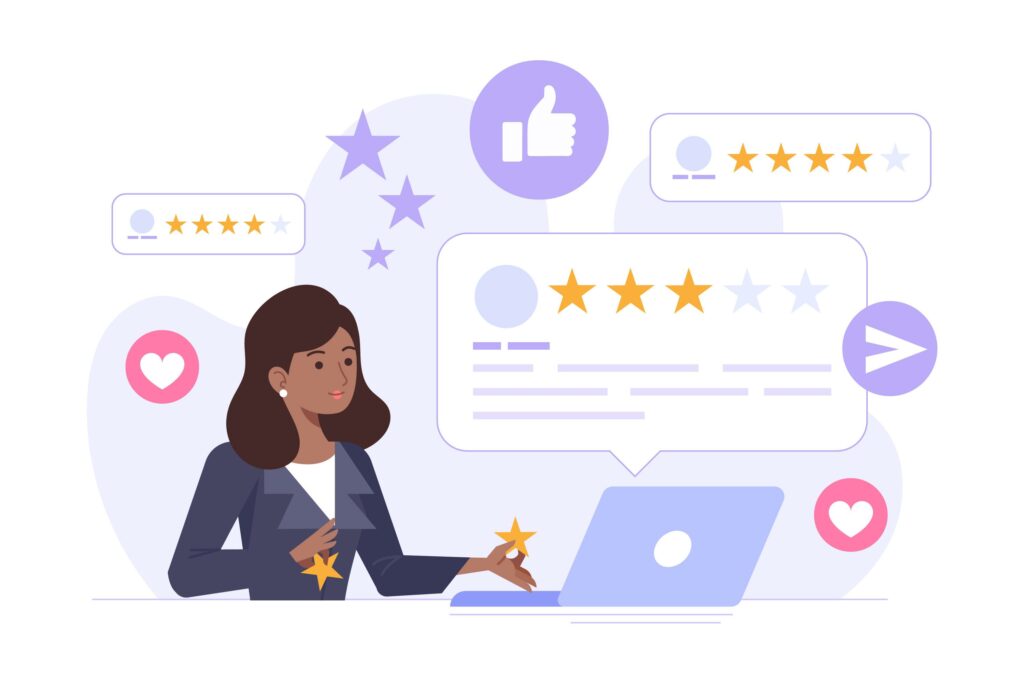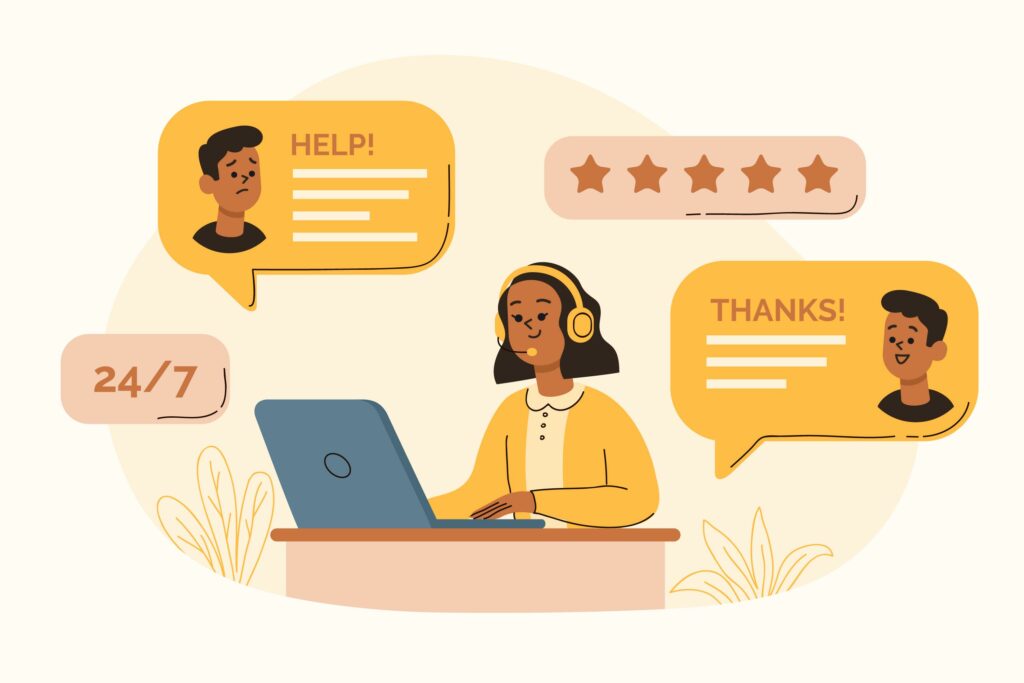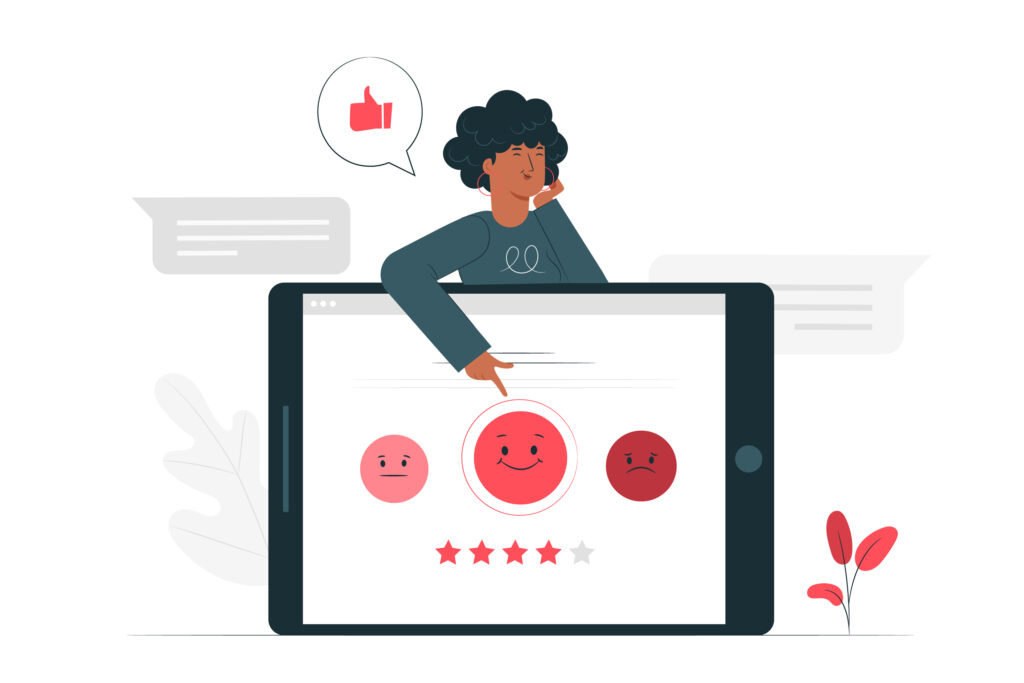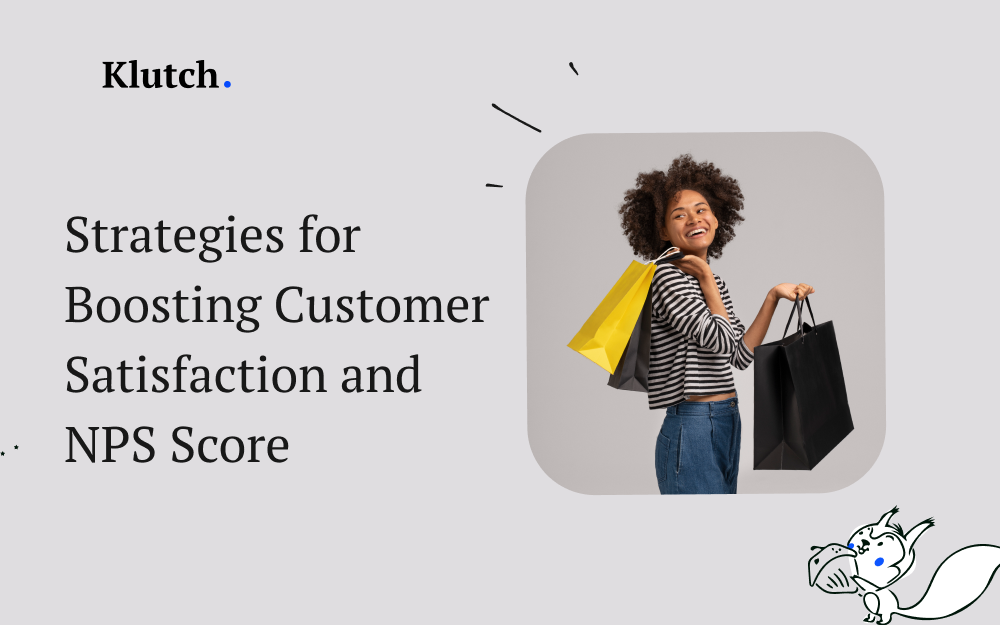Increasing customer satisfaction and Net Promoter Score (NPS) is important for businesses aiming to attract and retain customers. Implementing strategies such as live chat solutions, proactive support, and continuous feedback collection can significantly boost customer satisfaction and, subsequently, result in more customers who refer others and provide valuable feedback. Read on to discover how you can improve your NPS and increase customer satisfaction through these strategies.

Understanding Net Promoter Score (NPS)
Net Promoter Score (NPS) is a robust metric designed to measure customer loyalty and contentment. It revolves around a fundamental question: “On a scale of 0 to 10, how likely are you to recommend our products or services to a friend or colleague?” Based on the customers’ responses they are categorized into three groups:
- Promoters (Score 9-10): These are your enthusiastic and loyal customers who not only cherish your business but also actively recommend it to others.
- Passives (Score 7-8): Passives are generally content with your offerings but are not necessarily your biggest enthusiasts. They might recommend your business if asked but are less likely to do so proactively.
- Detractors (Score 0-6): Detractors are dissatisfied customers who may even discourage others from using your products or services.
NPS is calculated by subtracting the percentage of Detractors from the percentage of Promoters, resulting in a score that ranges from -100 to +100. The higher your NPS, the more satisfied and loyal your customer base.
Why NPS is Vital for Measuring Customer Satisfaction and Loyalty
NPS serves as an important metric for understanding customer satisfaction and loyalty. Unlike complex and lengthy customer surveys, NPS condenses the essence of customer sentiment into a single number. This simplicity is its strength, allowing for effortless tracking and immediate action. Here’s why NPS is essential for businesses:
- Conciseness: NPS is concise and comprehensible for both businesses and customers. It offers a clear and direct insight into customer loyalty.
- Real-time Feedback: NPS can be collected at various touchpoints, offering real-time feedback for businesses to act upon promptly.
- Actionable Data: The feedback garnered through NPS surveys is eminently actionable. It pinpoints specific areas requiring improvement.
- Customer-Centric Approach: NPS places customers at the center. By aiming to increase NPS, businesses inherently prioritize customer satisfaction and loyalty.
- Loyalty and Growth: A high NPS score signifies more loyal customers who not only stay but also become advocates, driving growth through referrals and positive word-of-mouth.
In essence, NPS is not just a metric; it’s a strategic tool for measuring, enhancing, and leveraging customer satisfaction and loyalty, ultimately promoting business success.

Strategies to Increase Customer Satisfaction
#1: Live Chat
Live chat is a real time chat support software embedded on websites and applications, connecting customers to support representatives or agents. This creates a seamless and responsive support ecosystem, allowing customers to have their questions answered, issues resolved, and concerns addressed at the speed of a light.
How Live Chat Enhances the Customer Experience
Having a live chat widget on your website transforms the customer experience by creating an environment where:
- Instant Accessibility: Customers can reach out to businesses at any time, day or night, ensuring support availability when it’s most convenient for them.
- Personalized Interaction: Live Chat allows for more personalized, one-on-one interactions, where agents can tailor their responses to the specific needs and concerns of each customer.
- Faster Issue Resolution: Issues and questions are resolved promptly, eliminating long hold times and delayed responses.
- Proactive Problem-Solving: Businesses can proactively address issues before customers even realize they have a problem, showcasing a high level of service.
- Effortless Multi-Channel Engagement: Live Chat can seamlessly integrate with other support channels, offering a consistent experience across the board.
#2: Proactive Customer Support
Proactive customer support is a strategy that involves anticipating and addressing customer needs and issues before they even arise. Instead of waiting for customers to reach out with problems, businesses take the initiative to provide assistance, guidance, and solutions at the right moment. This approach not only impresses customers but also creates a sense of care and attentiveness that can significantly enhance satisfaction.
Examples of Proactive Support Strategies
Proactive support can take various forms, including:
- Behavior-Based Initiatives: By monitoring customer behavior on a website or app, businesses can identify when a customer might be experiencing difficulties or has questions. Proactive chat invitations, informative pop-ups, or personalized recommendations can be offered based on this behavior.
- Educational Content: Providing customers with educational content such as how-to guides, tutorials, or troubleshooting tips can help them resolve issues on their own. Businesses can also send this content proactively based on customer activities or previous support interactions.
- Product or Service Updates: When businesses release updates or new features, they can proactively inform customers and provide guidance on how to make the most of these changes.
- Notification of Issues: If a business is aware of a potential issue or outage that might affect customers, they can proactively notify customers about it, reassuring them that the problem is being addressed.
- Check-Ins: Periodically checking in with customers to see if they are satisfied or if they need any assistance can create a positive customer experience. It shows that the business values the customer’s opinion and well-being.

#3: Personalization and Tailored Experiences
Personalization is the art of tailoring experiences, products, and services to the specific preferences and needs of individual customers. It’s a strategy that goes beyond treating customers as generic entities, aiming to make each customer feel unique and valued. This level of personalization can significantly impact customer satisfaction by creating a more meaningful and engaging experience.
Implementing personalization involves:
- Data Collection: Gathering data about customers’ behaviors, preferences, and interactions is crucial. This data can be collected through website activity, purchase history, and customer feedback.
- Segmentation: Grouping customers into segments based on shared characteristics or behaviors allows for more effective personalization. For example, segmenting customers by purchase history enables businesses to recommend products or offers tailored to each group.
- Recommendations: Recommending products, services, or content based on a customer’s previous interactions and preferences can enhance their experience. This is commonly seen in e-commerce platforms where customers receive personalized product recommendations.
- Personalized Communication: Using a customer’s name and sending personalized messages, such as birthday offers or anniversary messages, can create a sense of recognition and value.
- Customized Experiences: Tailoring the customer journey to individual needs can include options like customizing the user interface, suggesting next steps based on past behavior, or offering personalized assistance.
The Connection Between Personalization and NPS
- Increased Satisfaction: Personalized experiences make customers feel valued and understood. This leads to increased satisfaction and contentment.
- Enhanced Loyalty: Customers who receive personalized treatment are more likely to remain loyal to a brand, as they appreciate the effort put into meeting their individual needs.
- Positive Word-of-Mouth: Satisfied customers are more likely to become Promoters in NPS terms. They not only stay but also recommend the business to others, boosting NPS scores.
- Higher Retention: Personalization contributes to higher customer retention rates. Satisfied, loyal customers are more likely to continue doing business with the company.
#4: Quick Issue Resolution
One of the key determinants of customer satisfaction is the ability to resolve issues swiftly and effectively. Customers don’t just judge a business based on the problems they face; they also assess how well those issues are addressed. Efficient issue resolution not only ensures satisfied customers but can also convert potential Detractors into Promoters.
Strategies for Resolving Customer Issues Efficiently
Efficient issue resolution involves:
- Empowered Support Agents: Support agents should be empowered with the authority and resources to resolve customer issues without unnecessary escalations.
- Effective Communication: Clear, empathetic, and proactive communication is essential. Letting customers know that their issue is being addressed and providing regular updates can alleviate frustration.
- Knowledge Base and Self-Service: Providing customers with easy access to a knowledge base or self-service options can enable them to resolve common issues on their own.
- Effective Ticketing Systems: A streamlined ticketing system can ensure that issues are directed to the right personnel for resolution, avoiding unnecessary delays.
- Follow-Up and Feedback Collection: After resolving an issue, businesses can follow up with customers to ensure their satisfaction. Additionally, this is an opportunity to collect feedback and improve processes.
#5: Building Customer Trust and Transparency
Trust and transparency are fundamental pillars of a strong customer-business relationship. When customers trust a brand, they are more likely to be loyal, advocate for the business, and provide positive NPS scores. Transparency, on the other hand, fosters trust by being open, honest, and authentic in business practices.
Methods for Building Trust with Customers
Building trust with customers involves:
- Consistent Communication: Regular and open communication with customers builds trust. Keep them informed about important changes, updates, and issues.
- Honesty: Be honest in all interactions. If a mistake is made, admit it and take steps to rectify it. Customers appreciate businesses that take responsibility.
- Data Privacy: Protecting customer data is a significant factor in trust. Ensure that customer data is secure and used responsibly.
- Quality Assurance: Consistently delivering high-quality products and services builds trust. Customers should know they can rely on your business.
- Feedback Implementation: Listening to customer feedback and taking action based on their suggestions or concerns shows that you value their input.
By focusing on trust and transparency, businesses can create an environment where customers feel secure, valued, and satisfied, ultimately leading to higher NPS scores.
#6: Continuous Feedback Collection
Collecting customer feedback is more than a formality; it’s a strategic tool for enhancing customer satisfaction and NPS. Feedback offers insights into customer experiences, preferences, and areas needing improvement.
Implementing Feedback Collection Mechanisms
Effective feedback collection involves:
- Multi-Channel Surveys: Offering customers the opportunity to provide feedback through various channels, including email, website forms, and social media.
- Post-Interaction Surveys: Sending surveys immediately after customer interactions to capture real-time feedback.
- Incentives: Providing incentives such as discounts or entry into contests can motivate customers to share their thoughts.
- Feedback Analysis: Employing tools and techniques to analyze feedback for patterns, sentiments, and actionable insights.
Continuous feedback collection creates a feedback loop that not only enhances satisfaction but also leads to NPS improvements. Listening to customers and acting on their input demonstrates a commitment to their happiness.

#7: Employee Training and Empowerment
Employee training and empowerment are key factors in delivering exceptional customer experiences. Well-trained and empowered employees have the knowledge, skills, and authority to assist customers effectively, creating a strong foundation for satisfaction.
Strategies for Empowering Employees to Enhance Customer Experiences
Empowering employees includes:
- Comprehensive Training: Providing in-depth training to ensure that employees have a deep understanding of products, services, and customer needs.
- Empowerment: Granting employees the authority and autonomy to make decisions that benefit customers, even if it means deviating from standard procedures.
- Emphasizing Soft Skills: Training employees in communication, empathy, and problem-solving skills to handle customer interactions effectively.
- Feedback Loops: Establishing mechanisms for employees to provide feedback about customer issues and suggesting improvements.

Well-trained and empowered employees are more capable of delivering exceptional service, resolving issues efficiently, and creating satisfied customers, all of which lead to higher NPS scores.
Strategy 8: Encouraging Customer Advocacy
Customer advocates are individuals who not only express satisfaction with a business but actively promote it to their network. These advocates can have a significant impact on NPS by bringing in new customers and elevating the loyalty of existing ones.
Techniques for Turning Satisfied Customers into Brand Advocates
Turning satisfied customers into brand advocates involves:
- Referral Programs: Implementing referral programs that incentivize customers to refer friends and colleagues.
- Loyalty Programs: Creating loyalty programs that reward repeat customers and encourage them to become advocates.
- Positive Word-of-Mouth: Encouraging customers to share their positive experiences and testimonials through social media and reviews.
- Advocate Communities: Building online communities or forums where advocates can connect and share their experiences.
Customer advocates not only help acquire new customers but also contribute to higher customer loyalty and NPS scores. Encouraging advocacy is a strategic move to boost customer satisfaction.
Measuring Success: How It Affects Customer Satisfaction and NPS
To see if these strategies are working, just keep an eye on your NPS scores. Watch how they change after you put these strategies into action.
When NPS scores go up, that means customers are happier and more loyal. You can measure this by looking at how many customers stick around, how many new customers come in because of referrals, and how your income increases when NPS scores rise. To figure out if these strategies are worth the cost, compare what you spent to what you gained, including more money, fewer customers leaving, and the value of referrals.
Final Thoughts
In a nutshell, these strategies are your secret sauce for happier customers and a thriving business. Higher NPS scores mean content, loyal customers who bring in referrals and increased revenue. Keep an eye on those scores, and you’ll see the magic unfold – more satisfied customers, more growth, and a successful future.



